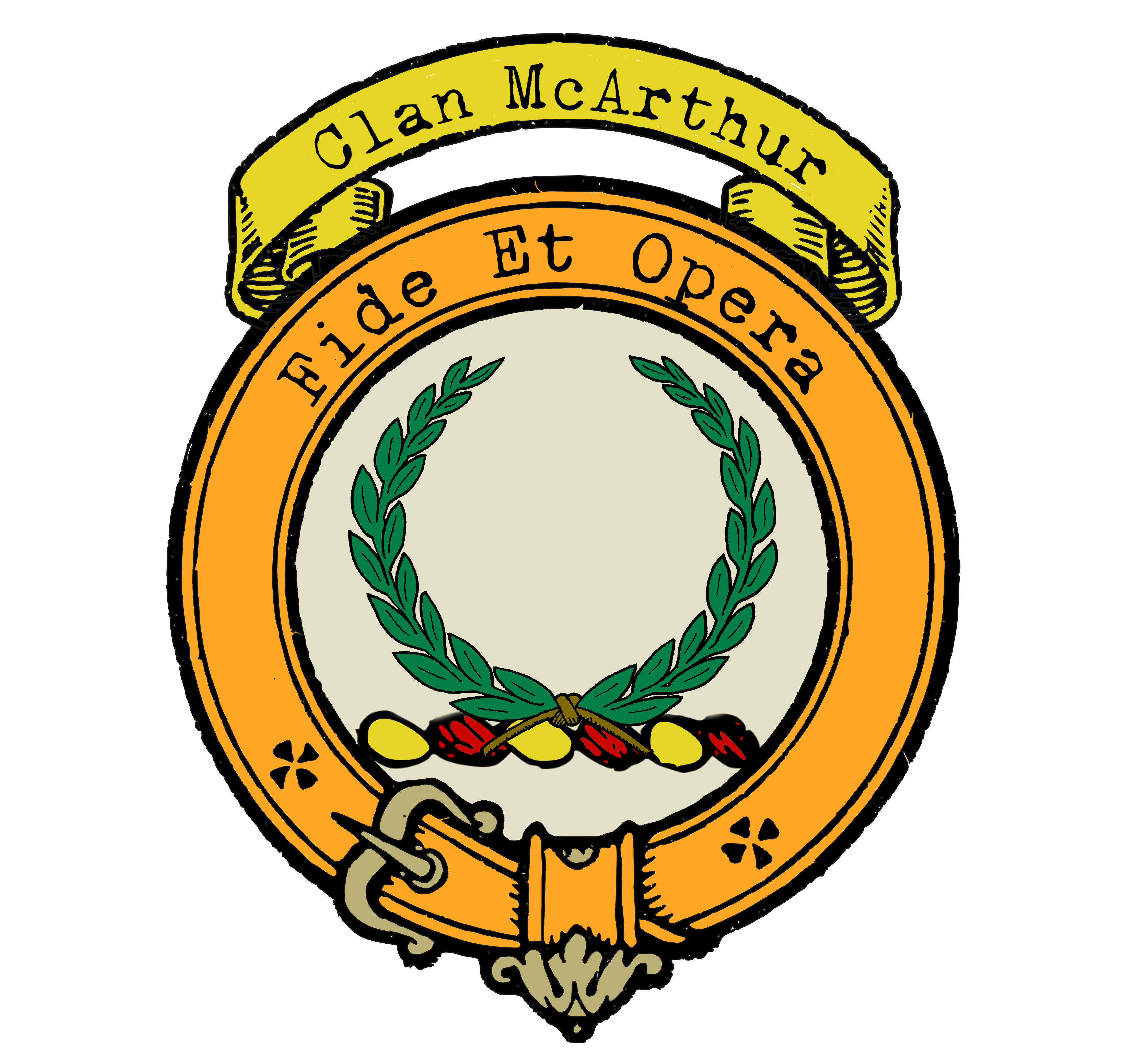Clan McArthur Crest
|
|
CREST: Two laurel branches in orle Proper MOTTO: Fide et opera TRANSLATION: By fidelity and labor VARIATIONS: MacArthur, Arthur |
| The roots of Clan McArthur stretch deep into the ancient past of the Celtic era. Considered one of the oldest clans in Argyll, the McArthurs proudly bear the Gaelic name “Clann Artair.” Legends recount a Gaelic couplet from remote Celtic times that posed the question, “the hills and streams and Macalpine, but whence came forth MacArthur?” This enigmatic query highlights the mysterious origins of the clan.During the struggle for Scottish independence, the McArthurs steadfastly supported Robert the Bruce, demonstrating their unwavering loyalty and dedication to their homeland. Led by Mac-Ic-Artiair, the McArthur clan played a pivotal role in the fight for freedom. As a reward for their allegiance, they were granted lands in mid Argyll, which had previously belonged to those who opposed the King. | |
 |
|
| Purchase @ Redbubble Purchase @ Amazon.com Purchase @ Amazon.co.uk |
|
| Over the centuries, the McArthur descendants dispersed and established themselves in various regions. One notable branch settled in Skye, where they founded a renowned piping school and served as hereditary pipers to the Macdonalds of Sleat. Charles MacArthur, a celebrated member of this family, received his piping education from Patrick Og Maccrimmon, further solidifying the MacArthur legacy in the world of Scottish music.Another branch of the McArthur family became armorers to the Macdonalds of Islay, showcasing their skills and forging connections with other influential clans. Two prominent branches of the clan emerged in the late 1400s around Loch Awe, gaining significant land and power. However, their rise to prominence also attracted envy, leading to conflicts and unfortunate events.
During the latter half of the sixteenth century, the McArthurs of Loch Awe faced adversity as their neighbors grew envious of their influence. In a skirmish in 1567, Duncan MacArthur and his son tragically drowned in Loch Awe. Recognizing the injustice, the Earl of Argyll ordered compensation and appointed John, son of Finlay, as the leader of the Loch Awe MacArthurs. Despite these challenges, the MacArthur name endured, leaving an indelible imprint on Scottish history. Like many Scottish clans, the McArthurs sought new horizons and opportunities abroad. One notable figure, Colonel John MacArthur, became the military deputy governor of St Kitts in the Caribbean. Following the Jacobite uprisings and the aftermath of the Battle of Culloden in 1746, a significant number of MacArthur clan members left Scotland, eventually settling in the West Indies, America, and Canada. In the 18th century, the direct male line of Clan McArthur faced a crisis. With the death of Patrick MacArthur in Jamaica in 1771 without a male heir, the official title of Chief of Clan Arthur ceased to exist. However, in the late 20th century, determined efforts were made to trace the lineage and find a rightful heir to the chiefship. In 2002, after extensive genealogical research, James Macarthur of Milton was recognized as the first chief of Clan Arthur in about 230 years. James Edward Moir MacArthur of Milton, the descendant of John MacArthur of Drissaig, successfully petitioned the Lord Lyon to be appointed Clan Commander of Clan Arthur. His efforts reinstated the rightful lineage and ignited a new era for Clan MacArthur. Under James Edward Moir MacArthur’s leadership, the clan experienced a revival of its traditions and heritage. In April 2003, he was officially inaugurated as the Chief of Clan Arthur, bringing a sense of unity and pride to the MacArthur clansmen worldwide. His commitment to preserving the clan’s history and fostering a sense of community among its members was commendable. Today, the current chief of Clan Arthur is John Alexander MacArthur of that Ilk, the son of James Edward Moir MacArthur. As a member of the Standing Council of Scottish Chiefs, Chief John Alexander MacArthur represents the clan and upholds its legacy with honor. Clan McArthur proudly embraces its heraldic symbols and motto. The chief’s armorial shield, bearing three antique crowns Or on an azure background, pays homage to the legendary King Arthur, whose name is intertwined with the clan’s history. The crest badge, featuring two branches of bay in orle, symbolizes the chief’s authority and ancestral ties. The Latin motto, “FIDE ET OPERA,” meaning “by fidelity and work” or “by faith and work,” exemplifies the values and principles upheld by Clan MacArthur throughout its existence. The McArthur tartans further encapsulate the clan’s identity and sense of belonging. While the MacArthur of Milton Hunting tartan shares similarities with the Campbell tartan, it stands as the elder of the MacArthur tartans, symbolizing the clan’s ancient heritage. The MacArthur tartan published in the Vestiarium Scoticum of 1842, although proven to be a Victorian hoax, still holds a place of significance in the clan’s historical tapestry. |
|
Citations:
|
|

